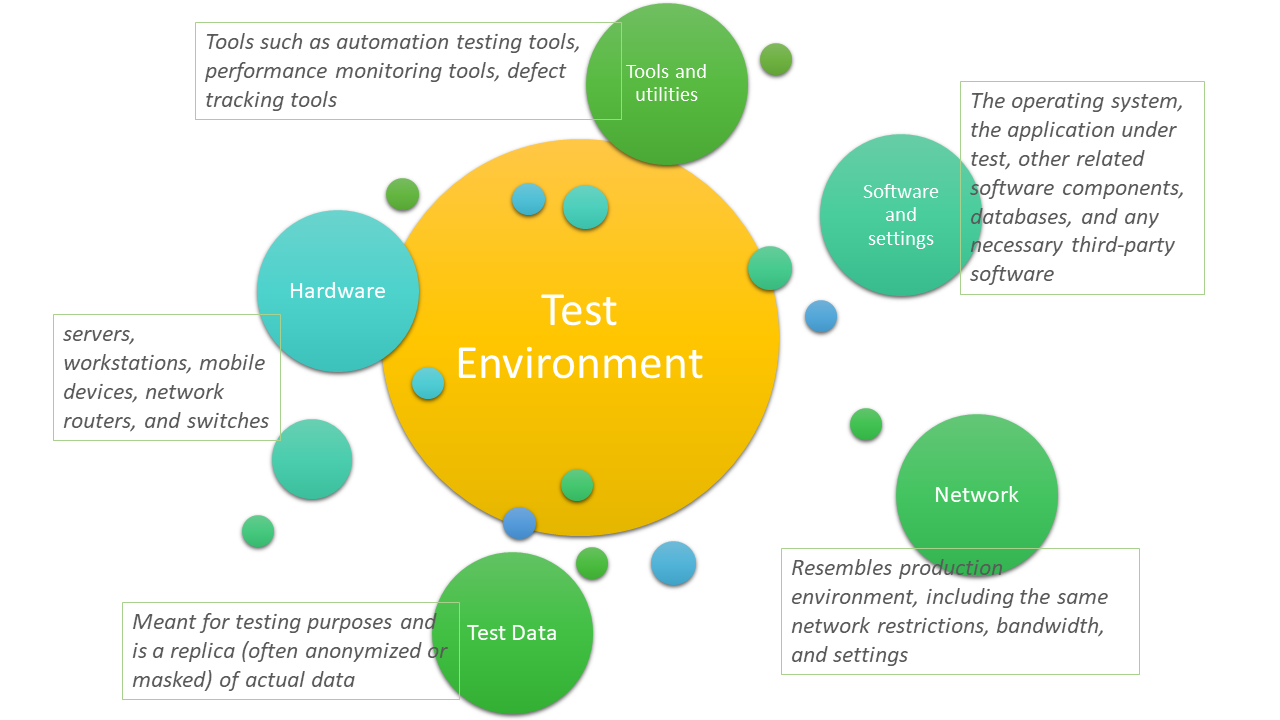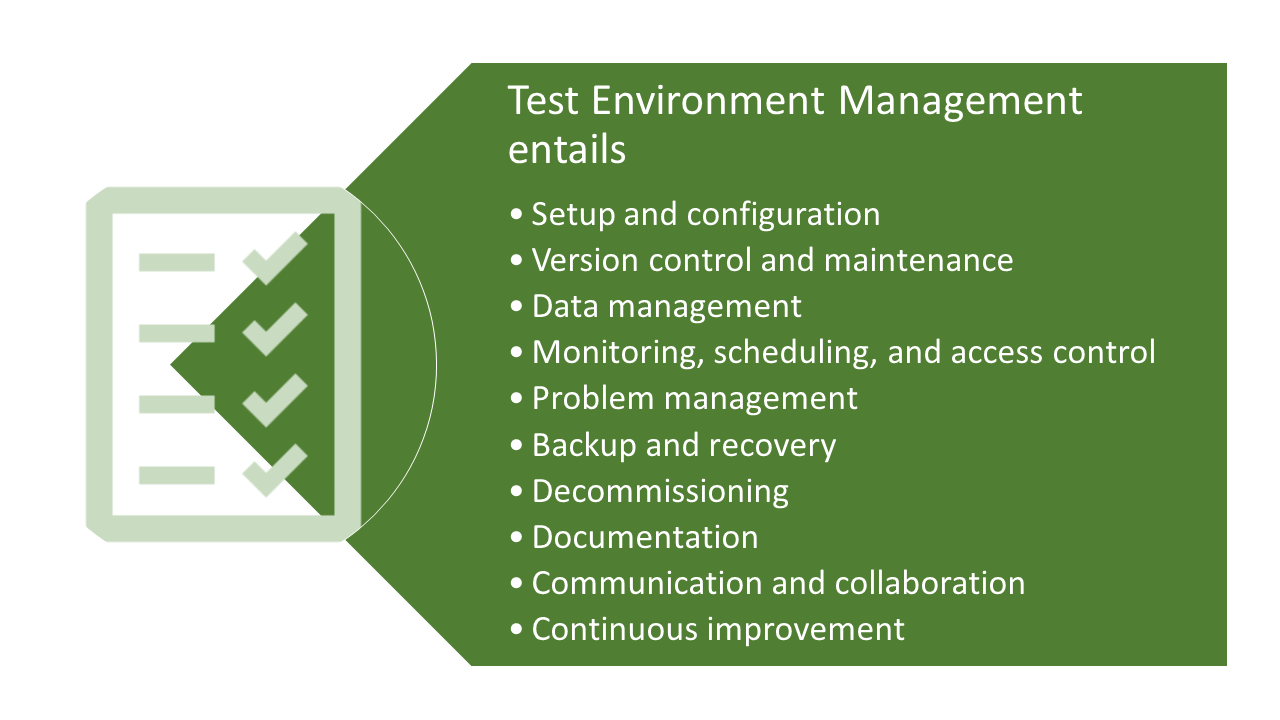Managing Your Test Environment: What You Need to Know
|
|
When a software application is being developed, every stakeholder involved would want to test their part of the application. For example, a developer will try to check if the functionality he coded gives the expected outcome. Likewise, a tester will try to perform different types of tests ranging from functional testing to performance and security testing on said application. Even the customer would want to check the result through user acceptance tests and see if the provided requirements are met.
Where do they all test their part? Definitely not production because that would wreak havoc. These dedicated testing workspaces are made available in the form of test environments.
What is a test environment?
You can view a test environment as a dedicated and controlled workspace. The aim is to mimic the production environment to give a real-world work environment for testing, though these test environments are always isolated and not a replica of production.
What does a test environment comprise?

What is test environment management?
There can be more than one test environment, each one having its own set of requirements. It thus becomes imperative to manage these different environments and their resources so that testing can yield the most accurate results. Test environment management focuses on establishing, maintaining, and coordinating these test environments.
Steps involved in test environment management

The various aspects of test environment management are as follows.
- Setup and Configuration: At the heart of it all, you have got to set the stage. This means getting the right hardware, software, databases, and network configurations in place so that testing can roll out without a hitch.
- Version control and maintenance: We have to have suitable software versions and keep them in sync with what is actually being tested. And yes, this also means doing routine maintenance checks to make sure everything is working as it should.
- Managing Test Data: We need the right kind of data for testing. This might also include anonymizing and masking or changing sensitive information. Optimize software testing with these effective Test Data Management tools.
- Monitoring, scheduling, and access control: With all the juggling that goes on for shared resources like the test environment, you have to make sure that different teams do not crash into each other’s work. Plus, not everyone should have the keys to the kingdom. Hence, using access control and some nifty monitoring tools will help you be on top of things.
Understand more about test monitoring and control.
- Backup and recovery: Regular backups and having a game plan for recovery ensure we bounce back quickly if things go sideways.
- Decommissioning: Sometimes, you will need to shut down, archive, or change parts of the test environment that are not required anymore.
- Keeping Records: Record keeping includes everything – configurations, changes, who accessed what, and so on. Great for troubleshooting and, well, keeping track.
- Communication: Keeping everyone in the loop, from the techies to the big bosses, is a must-have. Everyone should know what is up with the test environment.
- Continuous improvement: Keeping up with the tech world using new technology and methods will make sure that you stay ahead of the curve and create an environment that accommodates this. Here is a roadmap to better Agile testing.
Test environment v/s staging environment v/s testbed
The test and staging environments are specialized setups where testing takes place. At the same time, testbed refers to the specific configuration and data within those environments tailored for particular test scenarios or cases.
Test Environment
The main intention of working in this environment is to check quality and look for bugs and discrepancies. You will usually see several test environments where different forms of testing, like unit testing, integration testing, end-to-end testing, and performance testing, are carried out.
Test environments are not always an accurate replica of the production environment but rather act as a playground for testers, often having different setups so that testers can verify various features. Access to this environment is usually limited to testers and developers. Read here the best approach to test in production.
Staging environment
A staging environment replicates the production environment and is the final pit stop before releasing code to production. Unlike test environments meant for testing specific features, the staging environment is intended for testing the whole application, thus making it an excellent place to run end-to-end tests and even performance checks. It simulates the live/production environment as closely as possible, allowing the team to validate the software under near-real conditions without affecting actual users. You will see this environment being used for final verification and even for client demos or training.
Testbed
Finally, testbeds are more targeted as they are a combination of test environments and test data and are a setup for a particular type of testing or a specific test case. For example, a testbed for mobile app testing might involve specific devices, operating systems, and network conditions, and hence, the test environment will be modified accordingly to create this testbed.
Benefits of managing your test environment
Using test environments, you can reap multiple benefits, even if it may initially seem like a significant investment.
- Better QA: This is the most significant advantage of having playgrounds for testers to experiment in. Issues can be identified and fixed early without affecting users in production. Test environments can be made to resemble the production environment as well, and hence, testing that needs this kind of setup can be done as well, without relying on the production environment to verify results— read testing methodologies to propel your QA forward.
- Quicker delivery cycles: By maintaining test environments for testing at different levels for developers and testers, you can streamline the entire QA process and make it efficient, thus reducing the time-to-market. Multiple stakeholders can test simultaneously on different environments with different setups as well.
- Risk mitigation: A considerable advantage of this multi-pronged approach to testing is identifying bugs, that is, risks, and then mitigating those.
- A standard environment for testing: By managing test environments, you can make sure that stakeholders are exposed to the right kind of environment for testing. This standardization helps in benchmarking results, understanding performance metrics, and ensuring reliable test outcomes. Here are the essential QA metrics to follow.
- Better productivity: If test environments are appropriately managed, then testers and developers can focus on their primary tasks without sweating over the technicalities of a working test environment.
- Is flexible and scalable: A well-managed test environment can be easily scaled up or down based on requirements, ensuring flexibility in handling different testing needs, from minor tests to large-scale performance testing. Read more about test scalability.
Tips for effective test environment management
Whether this is your first time creating a test environment or your nth, you can refer to these practices to fine-tune your process and make sure that your test environment is efficiently managed.
Share environment-related updates regularly
Test environments are going to be used by different teams, so be transparent in your communication related to downtimes, new releases, and other resource or feature updates.
Strategically prepare test environments within your budget
You can be calculative here and prepare test environments for different aspects of the software development lifecycle or even for different testing types. For example, you could have four environments: a development environment exclusively for developers, a QC environment for testers, a UAT environment for business stakeholders and even client testers, and even a staging environment. However, make sure that all this is within your budget.
Read here how to save budget on QA.
Use automation
Use CI tools like Jenkins to automate the deployment of versions to all your test environments. Moreover, you can use some form of automation testing to ensure that a primary round of smoke testing is done on these environments before they are opened up to teams for use.
Follow the software testing lifecycle (STLC)
The software development lifecycle (SDLC) already proclaims a specific phase for testing. Make use of it while syncing with your organization’s development cycle to release changes into the different test environments. Read here in detail about the software testing lifecycle (STLC).
Regularly evaluate test environments and their metrics
If a test environment does not serve the intended purpose and instead poses a hindrance to team members, then it is an utter waste. Be vigilant and try to monitor test environment metrics regarding performance, downtime, and issues observed to see if the environments are significant and relevant to testers.
Recycle test environment resources
Be judicious with resource allocation. Through access control and scheduling environment usage, track who can access the test environments to make sure that there isn’t a bottleneck being created. Moreover, you should try to make sure that resources are shared rather than duplicated or hoarded amongst team members. Not everyone needs an entire test environment to themselves.
Prepare guidelines for test environment usage
Lay down ground rules for general usage of test environments to maintain consistency and sanity. For example, if a team is testing a feature by enabling a feature flag, then they should turn it off as well once the testing is completed. This will help ensure that others who will be using that environment can start from scratch and are not confused or thrown off by the new feature. Since test environments are common testing grounds, they should be maintained with that in mind.
Test environments and automation testing
Once you’ve set up your test environment, you can use various automation testing tools to automate different types of tests, like end-to-end tests, unit tests, integration tests, performance tests, load tests, functional tests, etc.
A great option in the market for this is testRigor. With a powerful tool like testRigor, you can easily automate tests on different environments, platforms, and across browsers. All you need to do is provide the URL to your test environment, or you can even integrate it with your CI tools.
This tool uses AI through and through to make test creation a piece of cake by allowing you to write tests in plain English. It simplifies this process so that you do not need to worry about implementation details like CSS tags or XPaths to identify elements on the screen. Using its generative AI capabilities, you can further simplify test case creation by simply providing a URL and a description of the test case and letting testRigor generate test steps to a certain extent.
Loaded with many powerful capabilities, this tool integrates smoothly with other CI/CD tools for smooth integrations. You can derive a basic report of your executed test suites per environment through the reports section. The best part of using testRigor is that it uses AI to primarily reduce the test maintenance costs so that you and your team can focus on creating tests rather than fixing them repeatedly.
Read here about the role of AI in the software testing landscape.
Conclusion
Creating and managing test environments streamlines the testing process, ensures that software is tested under optimal and standardized conditions, and brings about operational efficiencies that lead to better quality and faster delivery. Pair it with powerful tools like testRigor to further boost productivity, and then you can rest assured knowing that these tools are taking care of most of the process for you.
| Achieve More Than 90% Test Automation | |
| Step by Step Walkthroughs and Help | |
| 14 Day Free Trial, Cancel Anytime |












